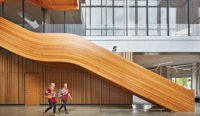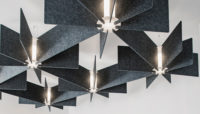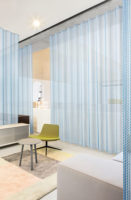Cork—used for decades for flooring to acoustical ceiling and wall tiles—isn’t a new building material. But cork finishes have evolved in appearance, performance, and application.
More pliable than most people realize, cork is appearing in more textile products in recent years. HBF Textiles’ Cork Cloth, conceived by New York architect Erin Ruby, is a contract-grade upholstery fabric (also usable as a wall covering or panel wrap) that feels just as luxurious as leather but is vegan. The cork face comes in five sophisticated colors with a stain-resistant waxy protectant and a backing composed of polyurethane, polyester, and cotton.
Similarly, Wolf-Gordon’s Natural Wallcovering 01 line is a textile-like covering for vertical surfaces with a 100 percent cork face on a woven polyester-cotton backing. But in addition to more neutral and subdued colors, the face is also available in bold tones including red, purple, green, and orange. These 54-inch-wide wall coverings are Class A fire-rated.
There’s also cork that doesn’t look anything like cork. Recently launched brand Sugo Cork Rugs produces fashionable contemporary floor rugs that weave the material together with wool yarns to offer a spectrum of color options and create intriguing patterns. One such example is Wadi, a chevron design that comes in custom sizes of up to nearly 79 inches wide and with finished sewn or fringed edges.
In the hard-flooring category Cali Bamboo’s Silverwood also tricks the eye: This click-lock floating floor looks just like weathered wood with a grain texture but is actually engineered of cork including some that has been reclaimed from the wine-bottling industry. It boasts sound and temperature insulation, natural elastic properties for a more comfortable walking surface, and mold and moisture resistance that makes it suitable for installation in bathrooms and kitchens. Silverwood is finished with GreenClaimed Ceramic Shield Technology, which consists of an edge sealant, primer, varnish, and ceramic layers.







Post a comment to this article
Report Abusive Comment